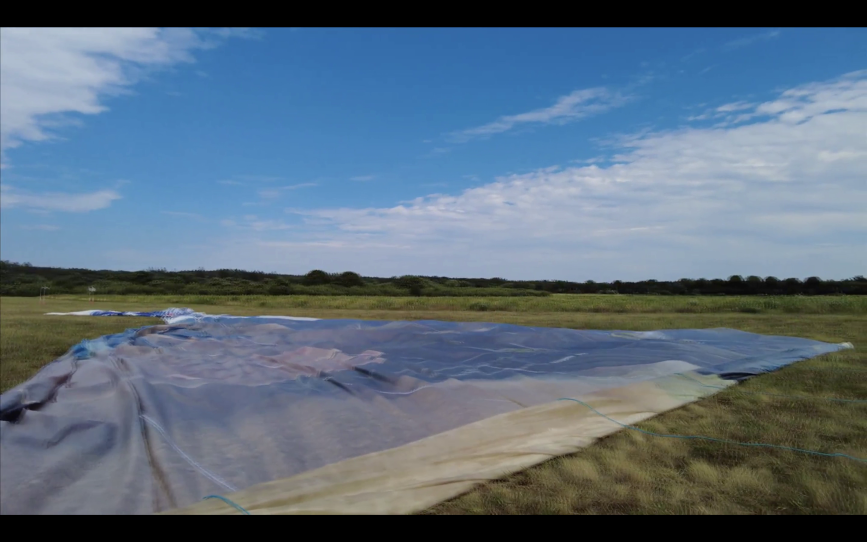A summer day at the beach could be viewed as something of a time capsule. Sure, folks now have smartphones and moisture wicking swimwear, but much has remained largely unchanged for decades: the smell of sunscreen. The sound of the gulls. Books being read in an umbrella’s shade. Kids of all ages splashing in the surf.
And the occasional airplane, ambling low in the sky over the water, with a banner in tow. It’s this time-honored aspect of the beach experience that recently piqued the curiosity of Braintree’s Deb McMartin. She reached out to The Curiosity Desk for help.
“My question,” she asked, “is those planes that fly by that have the trailing banners — how do they take off and how do they land with those things?”
For an answer, Deb and I went to Cape Cod Airfield in Barnstable, where we met up with pilot, mechanic and airport manager Chris Siderwicz. He and his father have been in the banner-towing game for decades.
“This place has been here since 1929, so over 90 years now,” he said. “I've been here since I was in diapers, so I'm sort of born into it. I was literally putting together a red-letter banner standing on a stool because I wasn't tall enough to reach the straps when I was really little.”
Flying those iconic, custom, red-lettered banners over beaches or weddings is still an important part of Siderwicz’s business. But in recent years, he said, pre-printed aerial billboards promoting national brands have increasingly been what pays the bills.
“Years ago, when I was a kid, it was almost all local businesses,” he said. But today? “It's mostly large national advertisers - liquor companies, insurance companies, things like that, that have big budgets.”
This comes as no surprise to Jeremy Levine, vice president of sales for Van Wagner Aerial Media. “It's a billboard in the sky and people see it,” he said.
Florida-based Van Wagner runs national banner campaigns. Their fleet flies banners for big brands all across the country — not just at beaches, but sporting events, city parades and music festivals. Levine estimates that aerial advertising, annually, is a $25 to $30 million industry. And the marketing firm, Advanced Market Analytics, forecasts it to grow in the coming years.
“Aerial is really great at reaching people at a time when they're open to brand interaction with a message that they will not miss,” said Levine. “It's going to be an unavoidable message that drives a high rate of recall and incredible brand awareness.”
Technology has changed the industry in some ways. Banners can be lighter, larger and more creative than they once were. Levine said Van Wagner twice flew banners this year featuring a giant QR code that, when captured by a person's phone camera from the ground, took them to a website that offered a tiny amount of free Bitcoin.
“They flew a day out at the Miami Bitcoin conference. And then in April they flew targeting the F1 race in Miami,” said Levine. “Both flights, they — before the flight was over — maxed out on the amount of free Bitcoin they were giving away.”

But at its core, the mechanics of towing a banner — and the experience for those on the ground — haven’t really changed much over the decades.
“I like to think of it like the great white shark,” said Levine. “The great white shark hasn’t evolved a lot over the past several million years, because it’s great at what it did and it’s great at what it’s always done.”
Back at the airfield, Siderwicz showed off the decidedly old-school way these banners get off the ground and into the sky.
“Everybody thinks: how do you take off with that thing? Well, you couldn’t physically take off with it,” he explained. “It’s just too big. It’d be too much drag. It wouldn’t be safe, it wouldn’t work.”
That means the banner needs to be snagged after take-off. This is achieved with two simple tools: A rope and a hook.
The banner is laid out and rolled up on the grass runway. Attached to the banner is a 275- to 300-foot rope that’s run along the ground to a set of poles. The poles are about 6 feet tall, and they are positioned about 6 to 8 feet apart. A big loop at the end of the rope is strung between the two poles. That loop is the target.

“The airplane has a grapple hook coming from a release in the back that comes to the cockpit,” Siderwicz said.
Just after takeoff, the pilot deploys that hook, and positions the plane well behind the poles. “We set up for a descent at the poles [and] we actually swing this hook through the poles,” Siderwicz explained. Once the hook captures the loop in the rope, the plane pulls up rapidly, unfurling the banner as it’s lifted off the ground. “This isn’t simple stuff, so you’re going to have a hiccup every now and then,” he said.
And sometimes worse.
In an email, an FAA spokesperson said, “any pilot seeking to tow a banner must satisfy various safety requirements and obtain a specific waiver. Still, the work can be dangerous. Just this year, there have been fatal crashes involving banner planes at Cape May in New Jersey and Myrtle Beach in South Carolina.
“This is hand flown, real pilot stuff,” Siderwicz said. “It’s all hand-eye coordination, timing, and it’s, you know, half a second here or there, you’ve got to be right on.”
Siderwicz brought the Curiosity Desk team, including our questioner, Deb McMartin, out to the grass runway at Cape Cod Airfield to witness the feat firsthand. Even knowing what was coming, the speed of the plane’s decent and its steep angle of ascent were startling to watch.
“Wow,” said a beaming McMartin. “Impressive.”
Once the plane is airborne and the banner has unfurled correctly, Siderwicz said, the pilots just fly.
“We cover every inch of Cape Cod,” he said. “It’s a lot of coastline, a lot of very busy beaches. We might just hit certain beaches or certain sections of the Cape, but we can do anywhere from an hour to four hours or even more.”

There’s still more work to do upon return though, as landing with a banner attached is just as much of a no-no as taking off with it.
“When you see it flying, you’ll see the banner hangs below the airplane,” Siderwicz said. “If you ever came in and let the banner beat you to the ground, it’s going to pull you out of the sky. That’s not good.”
So, before the wheels hit the grass, the pilot must literally let the banner off the hook.
“We come down and we descend over the banner area where we're going to drop, and then over a designated spot we’ll just pull the release and the banner will just come off and will just fall to the ground,” Siderwicz explained. “And the airplane just comes around and just lands like a normal airplane.”

From there, all that’s left is for the crew to collect the banner and start prepping the next one to go up. Summer is a lot of things at Cape Cod Airfield, but restful isn’t one of them.
“On a busy week, we’ll have three airplanes in the air, six to eight hours a day, at least three days a week, steady,” said Siderwicz. “That’s a lot of flying.”
Still, it took only one flight to impress Deb McMartin. “I kind of felt like Alfred Hitchcock in ‘North by Northwest’ for a second there when all of a sudden, they just went straight up with it,” she said. “I'm so glad I asked the question because that was so cool.”





